Reading time: 9 min
There was once a miller who was poor, but he had one beautiful daughter. It happened one day that he came to speak with the king, and, to give himself consequence, he told him that he had a daughter who could spin gold out of straw. The king said to the miller: „That is an art that pleases me well. If thy daughter is as clever as you say, bring her to my castle to-morrow, that I may put her to the proof.“
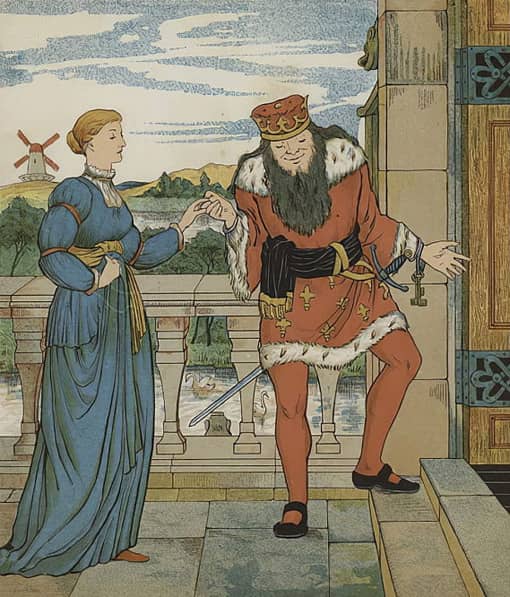
When the girl was brought to him, he led her into a room that was quite full of straw, and gave her a wheel and spindle, and said: „Now set to work, and if by the early morning thou hast not spun this straw to gold thou shalt die.“ And he shut the door himself, and left her there alone.
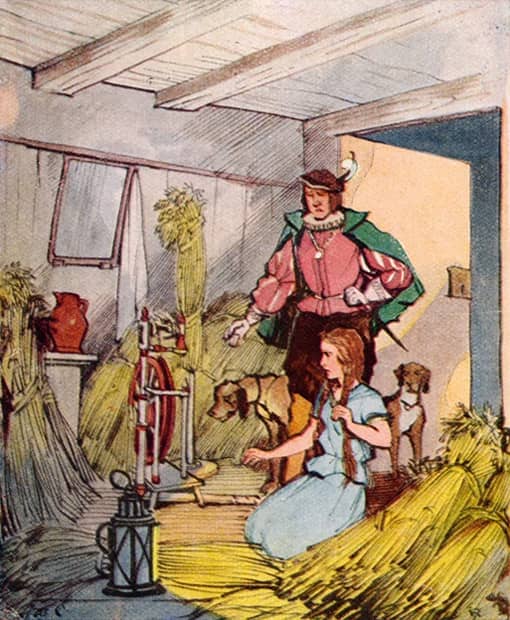 Image: Kurt Rübner (1875 – 1965)
Image: Kurt Rübner (1875 – 1965)And so the poor miller’s daughter was left there sitting, and could not think what to do for her life: she had no notion how to set to work to spin gold from straw, and her distress grew so great that she began to weep. Then all at once the door opened, and in came a little man, who said: „Good evening, miller’s daughter; why are you crying?“
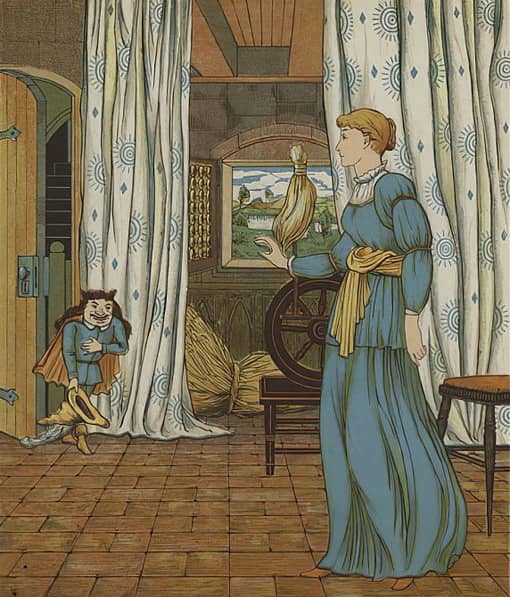
„Oh“, answered the girl, „I have got to spin gold out of straw, and I don’t understand the business.“ Then the little man said: „What will you give me if I spin it for you?“ – „My necklace,“ said the girl. The little man took the necklace, seated himself before the wheel, and whirr, whirr, whirr! three times round and the bobbin was full. Then he took up another, and whirr, whirr, whirr! three times round, and that was full; and so he went on till the morning, when all the straw had been spun, and all the bobbins were full of gold.
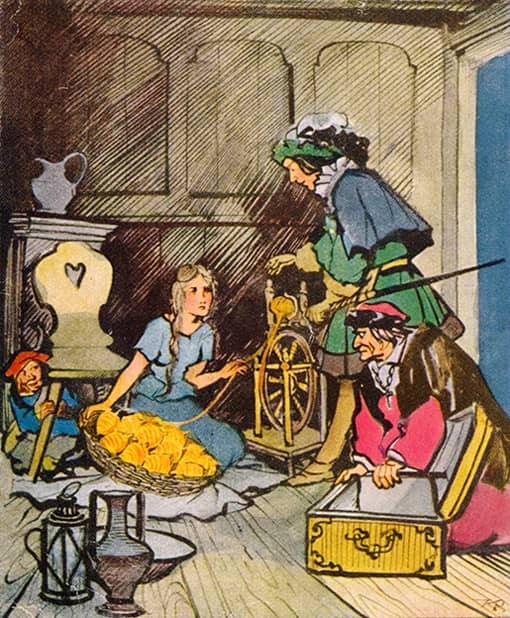 Image: Kurt Rübner (1875 – 1965)
Image: Kurt Rübner (1875 – 1965)At sunrise came the king, and when he saw the gold he was astonished and very much rejoiced, for he was very avaricious. He had the miller’s daughter taken into another room filled with straw, much bigger than the last, and told her that as she valued her life she must spin it all in one night.
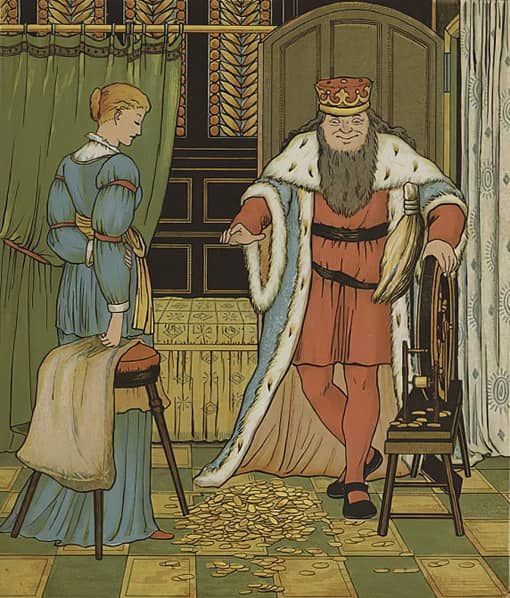
The girl did not know what to do, so she began to cry, and then the door opened, and the little man appeared and said: „What will you give me if I spin all this straw into gold?“
„The ring from my finger,“ answered the girl. So the little man took the ring, and began again to send the wheel whirring round, and by the next morning all the straw was spun into glistening gold. The king was rejoiced beyond measure at the sight, but as he could never have enough of gold, he had the miller’s daughter taken into a still larger room full of straw, and said: „This, too, must be spun in one night, and if you accomplish it you shall be my wife.“ For he thought: „Although she is but a miller’s daughter, I am not likely to find any one richer in the whole world.“
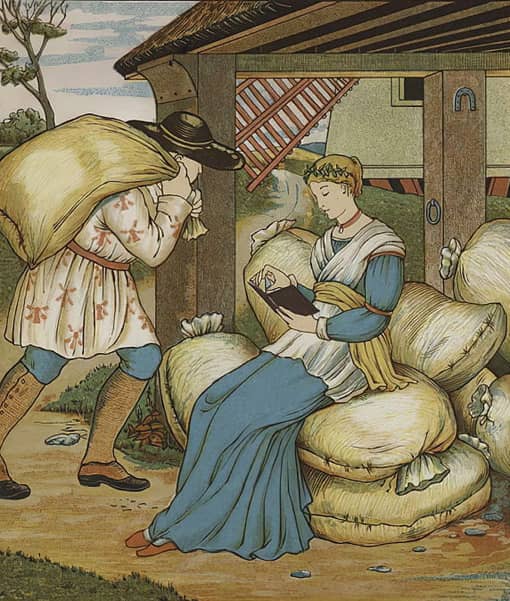
As soon as the girl was left alone, the little man appeared for the third time and said: „What will you give me if I spin the straw for you this time?“ – „I have nothing left to give,“ answered the girl. „Then you must promise me the first child you have after you are queen,“ said the little man. „But who knows whether that will happen?“ thought the girl; but as she did not know what else to do in her necessity, she promised the little man what he desired, upon which he began to spin, until all the straw was gold. And when in the morning the king came and found all done according to his wish, he caused the wedding to be held at once, and the miller’s pretty daughter became a queen.
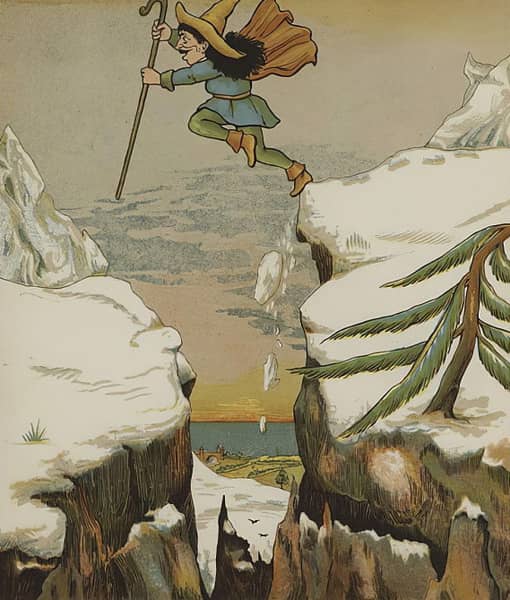
In a year’s time she brought a fine child into the world, and thought no more of the little man; but one day he came suddenly into her room, and said: „Now give me what you promised me.“ The queen was terrified greatly, and offered the little man all the riches of the kingdom if he would only leave the child; but the little man said: „No, I would rather have something living than all the treasures of the world.“ Then the queen began to lament and to weep, so that the little man had pity upon her. „I will give you three days,“ said he, „and if at the end of that time you cannot tell my name, you must give up the child to me.“
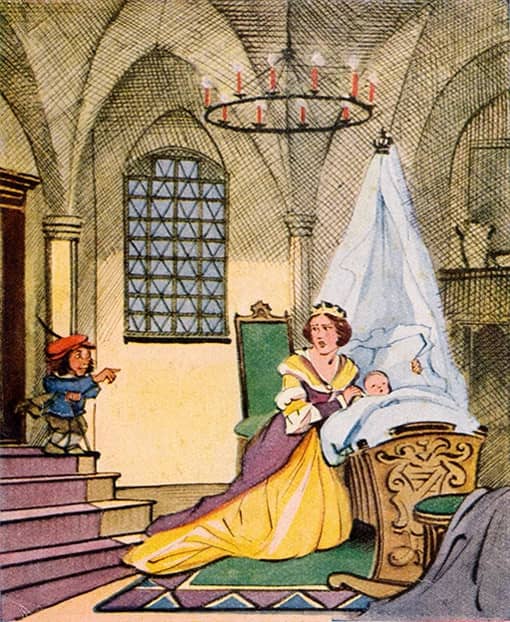 Image: Kurt Rübner (1875 – 1965)
Image: Kurt Rübner (1875 – 1965)Then the queen spent the whole night in thinking over all the names that she had ever heard, and sent a messenger through the land to ask far and wide for all the names that could be found.
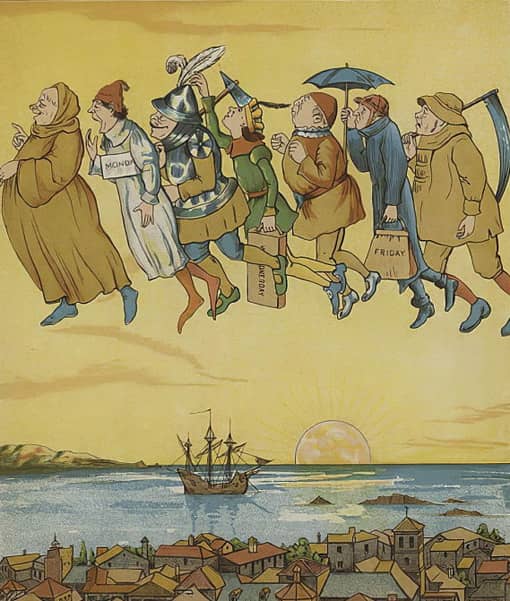
And when the little man came next day, (beginning with Caspar, Melchior, Balthazar) she repeated all she knew, and went through the whole list, but after each the little man said: „That is not my name.“
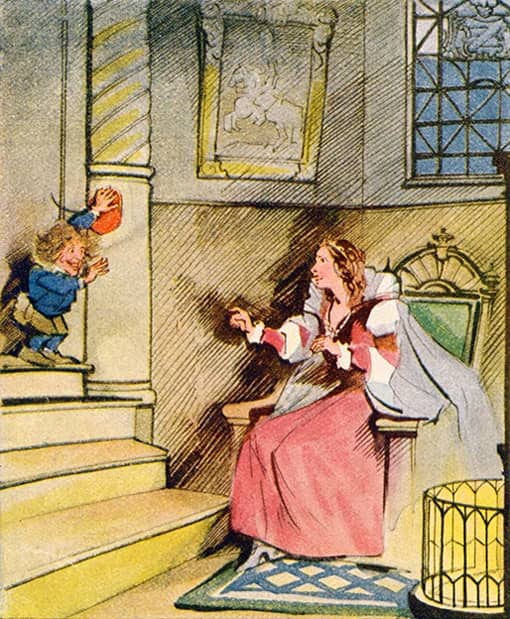 Image: Kurt Rübner (1875 – 1965)
Image: Kurt Rübner (1875 – 1965)The second day the queen sent to inquire of all the neighbours what the servants were called, and told the little man all the most unusual and singular names, saying: „Perhaps you are called Roast-ribs, or Sheepshanks, or Spindleshanks?“ But he answered nothing but: „That is not my name.“
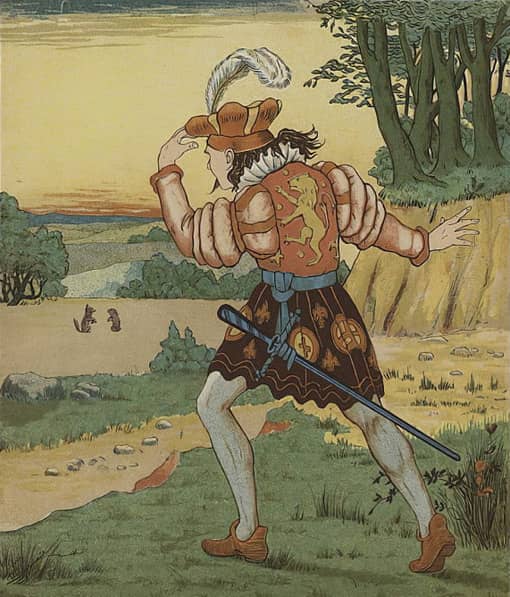
The third day the messenger came back again, and said: „I have not been able to find one single new name; but as I passed through the woods I came to a high hill, and near it was a little house, and before the house burned a fire, and round the fire danced a comical little man, and he hopped on one leg and cried:
„Today do I bake,
tomorrow I brew,
The day after that the queen’s child comes in;
And oh! I am glad that nobody knew
That the name I am called is Rumpelstiltskin!“
You cannot think how pleased the queen was to hear that name, and soon afterwards, when the little man walked in and said: „Now, Mrs.
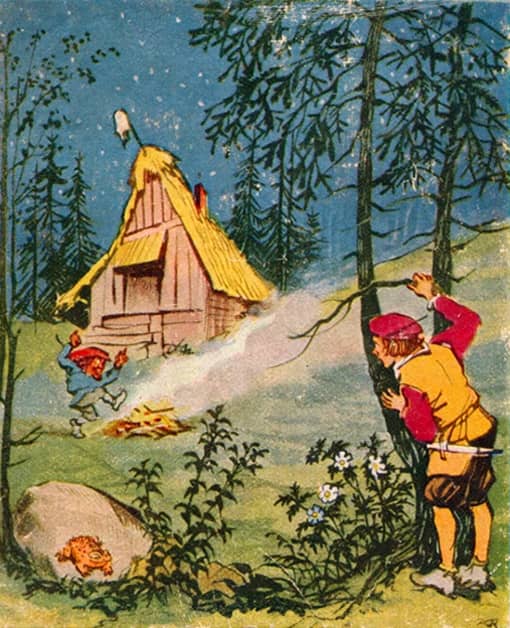 Image: Kurt Rübner (1875 – 1965)
Image: Kurt Rübner (1875 – 1965)Queen, what is my name?“ she said at first „Are you called Jack?“ – „No,“ answered he. „Are you called Harry?“ she asked again. „No,“ answered he. And then she said“: „Then perhaps your name is Rumpelstiltskin?“
„The devil told you that! the devil told you that!“ cried the little man, and in his anger he stamped with his right foot so hard that it went into the ground above his knee. Then he seized his left foot with both his hands in such a fury that he split in two, and there was an end of him.
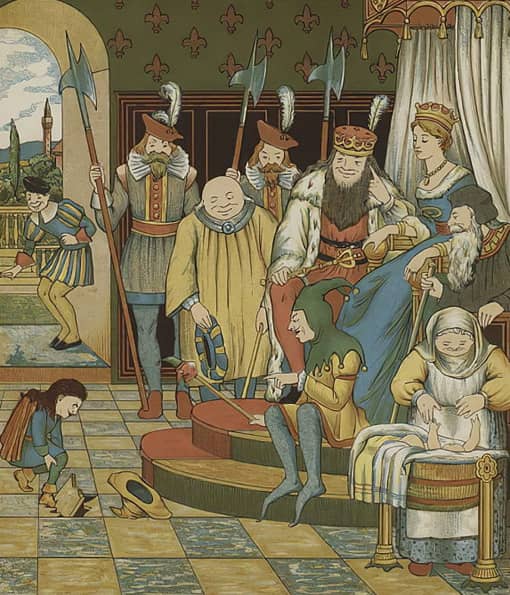
 Learn languages. Double-tap on a word.Learn languages in context with Childstories.org and Deepl.com.
Learn languages. Double-tap on a word.Learn languages in context with Childstories.org and Deepl.com.Backgrounds
Interpretations
Adaptions
Summary
Plot
Linguistics
„Rumpelstiltskin“ is a well-known fairy tale collected by the Brothers Grimm in their anthology „Grimms‘ Fairy Tales“ or „Kinder- und Hausmärchen.“ First published in 1812, the collection aimed to preserve and share German folktales and oral storytelling traditions that had been passed down through generations. Jacob and Wilhelm Grimm gathered stories from various sources, such as friends, family, and acquaintances, and edited them to create a cohesive collection of tales.
The story of „Rumpelstiltskin“ revolves around a miller’s daughter who is forced by a king to spin straw into gold. A mysterious little man, later revealed as Rumpelstiltskin, comes to her aid but demands her firstborn child in return. When the time comes to fulfill her promise, the woman is given the chance to keep her child if she can guess Rumpelstiltskin’s name. Ultimately, she succeeds and Rumpelstiltskin is defeated. „Rumpelstiltskin“ has its roots in the oral storytelling traditions of Europe, which were fluid and varied as stories evolved and changed with each retelling. The Brothers Grimm sought to capture these tales in written form, often editing and adapting them to fit the literary and cultural sensibilities of their time. As a result, the tales in their collection, including „Rumpelstiltskin,“ can be seen as a combination of the original oral tradition and the literary culture of early 19th-century Germany.
The Brothers Grimm, Jacob (1785-1863) and Wilhelm (1786-1859), were German academics, linguists, cultural researchers, and authors who collected and published numerous European folktales. Their work aimed to preserve the rich cultural heritage of these stories, which were passed down through generations by word of mouth. The tale of „Rumpelstiltskin“ has its roots in similar stories found across Europe. Some notable variants include the French tale „Le nain Tracassin“ (The Dwarf Tracassin) and the Scottish tale „Whuppity Stoorie.“ Although the details and names may differ, these stories share common elements, such as a magical helper who demands a high price for their assistance and the importance of discovering the helper’s name.
The story of „Rumpelstiltskin“ shares themes and motifs with other European fairy tales, such as the power of names, the importance of keeping promises, and the cunning of the protagonist. These elements resonate with audiences across different cultures and time periods, showcasing the enduring appeal of such stories and their ability to captivate and inspire generations of readers and listeners. Over the years, „Rumpelstiltskin“ has been adapted and retold in various forms, including stage plays, musicals, and films. The story continues to capture the imagination of audiences worldwide, thanks to its intriguing plot, memorable characters, and universal themes.
„Rumpelstiltskin“ is a classic fairy tale collected by the Brothers Grimm that has various themes and interpretations. Here are some possible interpretations of the story.
The Power of Names: A central theme in „Rumpelstiltskin“ is the power and importance of names. Knowing Rumpelstiltskin’s name gives the miller’s daughter the ability to break her contract with him and save her child. This emphasizes the significance of names and the power they can hold. The importance of names and the knowledge they hold is a recurring theme in many fairy tales, including „Rumpelstiltskin.“ In this story, knowing Rumpelstiltskin’s name gives the queen power over him, ultimately saving her child and defeating the little man.
The Importance of Keeping Promises: The miller’s daughter makes a promise to Rumpelstiltskin in exchange for his help, but later tries to break it when faced with the consequences. This interpretation highlights the importance of keeping promises and dealing with the consequences of one’s actions.
Cunning and Resourcefulness: The miller’s daughter is a resourceful and cunning character, who manages to outsmart Rumpelstiltskin by discovering his name. This interpretation focuses on the value of intelligence and resourcefulness in overcoming obstacles and adversaries.
The Danger of Exaggeration and Deception: The miller’s boast about his daughter’s ability to spin straw into gold sets the entire story into motion, ultimately putting his daughter in a dangerous situation. This interpretation serves as a cautionary tale about the consequences of deception and exaggeration.
The Role of Luck and Chance: The miller’s daughter only learns Rumpelstiltskin’s name through a chance encounter, which ultimately saves her child. This interpretation highlights the role of luck and chance in the story, emphasizing that sometimes events are beyond human control and intervention.
The Abuse of Power: The king in „Rumpelstiltskin“ is a character who abuses his power by forcing the miller’s daughter into a seemingly impossible task. This interpretation can prompt discussions about the abuse of power and the responsibility of those in authority.
Power and Greed: The story demonstrates the corrupting influence of power and greed. The king, driven by his lust for gold, forces the miller’s daughter into an impossible situation. The little man, in turn, exploits her vulnerability for his own benefit.
Cunning and Intelligence: The queen’s ability to outwit Rumpelstiltskin by discovering his name highlights the value of cunning and intelligence. The story suggests that these qualities can be more important than physical strength or magical abilities when it comes to overcoming adversity.
The Dangers of Deception: The miller’s initial lie about his daughter’s abilities sets off a chain of events that leads to dire consequences. This serves as a cautionary tale about the potential dangers of deception and dishonesty.
Resourcefulness and Resilience: Throughout the story, the miller’s daughter faces seemingly insurmountable challenges, but she never gives up. Her resourcefulness and resilience ultimately allow her to triumph over Rumpelstiltskin and protect her child.
Overall, „Rumpelstiltskin“ offers various themes and moral lessons that can resonate with readers and listeners of all ages. The story’s timeless messages about the power of names, the importance of keeping promises, and the value of cunning and resourcefulness continue to captivate and inspire audiences across different cultures and generations.
„Rumpelstiltskin“ is a German fairy tale that was first published by the Brothers Grimm in their 1812 collection, „Children’s and Household Tales“ (also known as Grimm’s Fairy Tales). The story is part of a rich oral storytelling tradition, with various versions existing across different cultures. „Rumpelstiltskin“ is a popular fairy tale that has been adapted into various forms over the years. Here are some specific examples of adaptations of this classic story:
Film and Television: „Rumpelstiltskin“ has been adapted into numerous films and television programs, both animated and live-action. For example, the 1987 film „Rumpelstiltskin,“ directed by David Irving, is a live-action adaptation of the story. The 1995 animated film „Happily Ever After: Fairy Tales for Every Child“ features an episode titled „Rumpelstiltskin,“ which reimagines the tale in a multicultural context. „Shrek the Third“: This animated film features a comedic retelling of the story, with the character of Rumpelstiltskin played by actor Conrad Vernon.
Theater: The story of „Rumpelstiltskin“ has been adapted for the stage in various forms, including plays, musicals, and ballets. For example, „Rumpelstiltskin: A Musical,“ with music by John Kavanaugh and lyrics by David Crane and Marta Kauffman, is a family-friendly musical adaptation of the story.
Literature: Numerous authors have retold or reimagined „Rumpelstiltskin“ in different literary forms. For example, in „A Tale Dark & Grimm“ by Adam Gidwitz, the story is incorporated into a larger narrative that interweaves multiple Grimm fairy tales. Vivian Vande Velde’s „The Rumpelstiltskin Problem“ offers a collection of six different takes on the classic tale, exploring various aspects of the story. „Rumpelstiltskin“ by Paul O. Zelinsky: This Caldecott Medal-winning children’s book features detailed illustrations and a faithful retelling of the original Brothers Grimm story. „Rumpelstiltskin“ by the Brothers Hildebrandt: This illustrated children’s book features a more fantastical interpretation of the story, with the title character depicted as a horned demon rather than a diminutive fairy. „The Fifth Elephant“ by Terry Pratchett: This novel in the Discworld series features a character named „Rumpelstiltskin“ who is actually a golem, a creature made of clay and brought to life through magical means.
Television Series: The character of Rumpelstiltskin has appeared in various TV series, often with a unique twist. In the popular series „Once Upon a Time“ (2011-2018), Rumpelstiltskin, played by Robert Carlyle, is a central character with a complex backstory, combining elements of various fairy tale characters. This television series incorporates numerous fairy tale characters, including Rumpelstiltskin, into its storyline. The character of Rumpelstiltskin, played by actor Robert Carlyle, is a major recurring character throughout the series.
Music and Audio: „Rumpelstiltskin“ has been adapted into audio form, such as radio plays or audiobooks, featuring voice actors, music, and sound effects to create an immersive storytelling experience.
Art and Illustration: Over the years, many artists have created illustrations for „Rumpelstiltskin,“ ranging from classic portrayals to more modern interpretations. These visual adaptations can be found in illustrated books, art prints, or online galleries. „Rumpelstiltskin“ by the Ballet Rambert: This ballet adaptation of the story features music by the composer Stephen McNeff and choreography by Mark Baldwin.
These are just a few examples of the many adaptations and retellings of „Rumpelstiltskin“ that have been created over the years. The story’s enduring popularity and timeless themes continue to inspire new interpretations and adaptations across a variety of media. These adaptations demonstrate the enduring appeal of „Rumpelstiltskin“ and its capacity to be reimagined and reinvented across different forms of media and for various audiences.
„Rumpelstiltskin“ is a classic fairy tale collected by the Brothers Grimm about a miller’s daughter who must spin straw into gold to save her life. The tale explores themes of deceit, cunning, and the power of names. The story begins with a poor miller who boasts to the king that his daughter can spin straw into gold. Intrigued, the king orders the daughter to prove her skill. If she fails, she will lose her life. Desperate and unable to perform the impossible task, the girl is visited by a mysterious little man who offers to help her in exchange for her necklace. He spins the straw into gold, and the king is impressed.
The king, still not satisfied, demands that the girl spin even more straw into gold. The little man returns to help her again, this time taking her ring as payment. The king, now convinced of her abilities, decides to marry her if she can successfully spin a final room full of straw into gold. If she fails, she will die. The little man reappears to help her one last time, but now she has nothing left to give him. Instead, he demands her firstborn child as payment once she becomes queen. Desperate, the girl agrees, and the little man spins the straw into gold. The king marries her, and they have a child together.
When the little man comes to claim the child, the queen begs him to reconsider. He agrees to let her keep the child if she can guess his name within three days. The queen sends a messenger to find out the little man’s name. The messenger comes across the little man, who is dancing and singing about his name, Rumpelstiltskin. On the third day, the queen correctly guesses the little man’s name, and in his fury, Rumpelstiltskin stomps his foot so hard that it sinks into the ground, and he disappears forever. The queen and her child are now safe, and they live happily ever after. „Rumpelstiltskin“ is a tale of deceit, cunning, and the importance of keeping promises, highlighting the power of names and the consequences of making deals with unknown forces.
„Rumpelstiltskin“ is a fairy tale by the Brothers Grimm about a poor miller who, to impress the king, falsely claims that his daughter can spin gold out of straw. The king brings the daughter to the castle and demands that she spin straw into gold, threatening her life if she fails. Distressed, the girl is visited by a mysterious little man who offers to perform the task in exchange for her necklace. She agrees, and the little man spins the straw into gold overnight.
The king is pleased but greedy, and he demands the girl spin even more gold from straw. The little man returns, and this time, the girl offers him her ring. When the king makes a third request, he promises to marry the girl if she succeeds. The little man agrees to help again, but in exchange, she must give him her firstborn child after becoming queen.
The girl marries the king and has a child, but the little man returns to claim his due. The queen, terrified, offers him all the kingdom’s riches, but he refuses. Instead, he gives her a chance to keep her child if she can guess his name within three days. The queen sends messengers to collect names and guesses many, but none are correct.
On the third day, a messenger returns with a story of a strange little man he saw dancing and singing about his name, Rumpelstiltskin. The queen correctly guesses his name, which infuriates the little man. In his anger, he stamps his foot so hard that it gets stuck in the ground. He then tries to free himself, but ends up splitting in two and perishing, thus saving the queen and her child.
A linguistic analysis of the Brothers Grimm’s fairy tale „Rumpelstiltskin“ can uncover various elements of language use, narrative structure, and thematic content.
Here are several aspects to consider
Exposition: The story begins by introducing the miller, his daughter, and their interaction with the king, setting the stage for the central conflict.
Rising Action: The girl is given increasingly difficult tasks of spinning straw into gold, each time solved with the help of the mysterious little man.
Climax: The deal for the first-born child puts the queen in a dire situation, leading to the climax of discovering the little man’s name.
Falling Action: The queen’s successful guess of „Rumpelstiltskin“ resolves the primary tension.
Resolution: The departure of Rumpelstiltskin and the queen’s relief conclude the tale.
Characterization: The characters are archetypal, typical of fairy tales, with clear roles: the naïve yet resourceful girl, the greedy king, and the cunning, supernatural helper. Direct speech and actions (e. g. , weeping, making deals) are used to convey emotions and motivations, revealing character traits effectively.
Repetition and Formulaic Phrases: The story employs repetition, particularly in the little man’s appearances and the tasks given to the girl, which reinforce the fairy tale’s rhythmic and predictable nature. Formulaic phrases, such as „whirr, whirr, whirr!“ and the repetitive nature of the girl’s challenges, create a ritualistic quality that is essential to traditional storytelling.
Dialogues and Style: Dialogues are formal and somewhat archaic, fitting the historical context of the tale’s origins. The use of direct speech drives the plot and reveals crucial story elements, like the conditions of each deal with the little man.
Themes and Motifs
Deceit and Bargaining: The miller’s initial lie sets off a chain of events involving deception and significant bargains.
Magical Assistance: The little man’s supernatural ability emphasizes the fairy tale motif of magical interventions.
Naming and Power: The revelation of the little man’s name signifies the control over the magical creature, highlighting the importance of knowledge and identity.
Greed and Consequences: The king’s insatiable greed nearly leads to tragedy, offering a moral caution.
Symbolism
Straw to Gold: This transformation symbolizes the unattainable tasks and miraculous solutions, a common element in fairy tales to convey wonder and enchantment.
The Necklace and Ring: Symbols of personal value and sacrifice, illustrating the girl’s desperation.
The First-born Child: Represents the ultimate sacrifice, hinting at themes of motherhood and the protection of the innocent.
In sum, the linguistic and narrative elements in „Rumpelstiltskin“ work together to create a rich and timeless fairy tale narrative, encapsulating both cultural values and universal themes.
Information for scientific analysis
Fairy tale statistics | Value |
|---|---|
| Number | KHM 55 |
| Aarne-Thompson-Uther-Index | ATU Typ 500 |
| Translations | DE, EN, EL, DA, ES, FR, PT, FI, HU, IT, JA, NL, PL, RO, RU, TR, VI, ZH |
| Readability Index by Björnsson | 31.2 |
| Flesch-Reading-Ease Index | 81.7 |
| Flesch–Kincaid Grade-Level | 7.3 |
| Gunning Fog Index | 9.8 |
| Coleman–Liau Index | 7.2 |
| SMOG Index | 7.8 |
| Automated Readability Index | 8 |
| Character Count | 5.875 |
| Letter Count | 4.391 |
| Sentence Count | 51 |
| Word Count | 1.126 |
| Average Words per Sentence | 22,08 |
| Words with more than 6 letters | 103 |
| Percentage of long words | 9.1% |
| Number of Syllables | 1.367 |
| Average Syllables per Word | 1,21 |
| Words with three Syllables | 32 |
| Percentage Words with three Syllables | 2.8% |
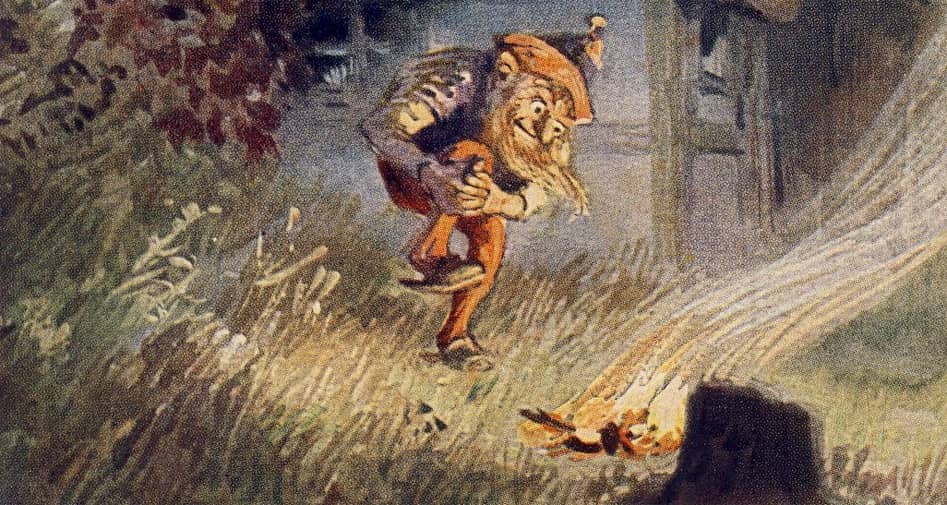
 Facebook
Facebook  Whatsapp
Whatsapp  Messenger
Messenger  Telegram
Telegram Reddit
Reddit













